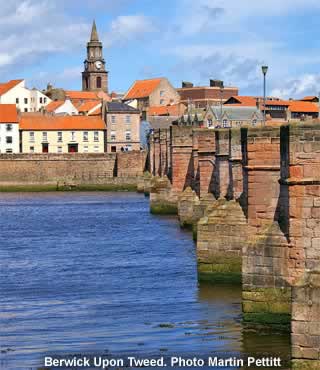Berwick Upon Tweed |
|
 |
|||
Britain > Northumberland > Berwick Upon Tweed |
A historic border town, that was constantly fought over |
Berwick-upon-Tweed - or Berwick for short - is a town on the border between Scotland and England. In early British history, the two countries were almost constantly fighting over it, and the town changed hands innumerable times. In 1482, when Edward IV captured it for the final time, the situation still wasn't resolved. Berwick came under English rule, but wasn't technically a part of the country. Even several centuries later, this was still true, and so when Victoria became Queen in 1837, her official title was "Victoria, Queen of Great Britain, Ireland, Berwick-upon-Tweed and the British Dominions beyond the sea." This name was written upon the declaration of war that Victoria signed against Russia, in 1853. Unfortunately, the town of Berwick was accidentally left off of the peace treaty which concluded the war 3 years later, leaving it technically still at war with Russia for a further century! Reportedly, when a peace document was finally signed in 1966, the Mayor of Berwick remarked: "Tell the Russian people that they can now sleep peacefully in their beds." |
Thanks to this turbulent history, Berwick is home to plenty of military buildings and structures. The most immediately obvious of these is the ring of Elizabethan walls surrounding the town. At the time, these were utterly state-of-the-art, and they cost a lot of money to make. They were apparently able to resist gunfire! Today, these walls are the only remaining examples of their kind that are still intact. They surround the town completely, with a circumference of about 3 kilometres. Walking the whole circuit takes about 45 minutes, and is a great way to see good views of both the town, and the sea. |
The town walls are arguably the major landmark of Berwick, and a big reason to visit. Contesting this claim though are the bridges. The River Tweed, as mentioned in the town's name, flows right through Berwick-upon-Tweed, and of course this waterway needs to be crossed. There are three bridges doing that job, of varying style and ages. |
The newest of these is the Royal Tweed Bridge. It's a road bridge that used to carry the main A1 route between London and Edinburgh. Nowadays the A1 bypasses Berwick to the west but the bridge still handles plenty of traffic. The Old Bridge, by contrast, is obviously the oldest of the three. It was built in the early 1700s, and is now a Grade-I listed structure. Before then, there was another bridge here. However, it had become so worn down that it was decidedly unsafe. When King James I made a crossing, he was so horrified that he ordered the construction of a new bridge immediately! The most impressive of Berwick's bridges though, is the Royal Border Bridge. A series of tall, dramatic arches carry the railway line across the water. It was opened in 1850 by Queen Victoria. |
These bridges make up just a small part of Berwick's collection of historical structures. Also in town is the Barracks, which is another result of Berwick being in a key military position. The Barracks contain several different museums, which tell the stories of soldiers and armies of the past. The site also holds an art gallery, containing both local and international works. |
Berwick has another link to the art community. From the 1930s onward it received frequent visits from L.S. Lowry, the celebrated painter, who was a huge fan of the place. He made several dozen works featuring all of the town's best views. A walking route called the Berwick Lowry trail takes you round most of the locations that inspired his paintings, including the pier, the harbour, and the old buildings in the centre of town. |
|
Pocket Britain is optimised for use on a smartphone or tablet with internet access. All content is subject to copyright. All reasonable methods have been used to ensure information supplied is accurate at the time of publication. However, it is advisable to check information before relying on it. Privacy Policy |